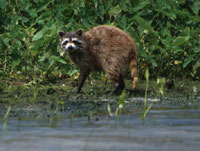Prevention and Control
Frightening Devices
Because raccoons are nocturnal, using various frightening devices such as lights, noise makers or playing a radio during the night can reduce damage. These methods are not effective for long because raccoons adapt to them.
Food and Cover Reduction
 A long term solution is to manage your home so you don't invite raccoon problems in the first place. You can do this by not leaving pet food outside at night and placing garbage in sealed metal containers, for example. You can also cap the chimney so raccoons and other wild creatures cannot get in. Remove trees growing next to the house. If you know animals jump from a tree onto your roof, place a sheet of slick tin on the roof's edge at that spot so animals will lose their footing and not be able to get onto the roof. Seal up all holes along the foundation and under steps.
A long term solution is to manage your home so you don't invite raccoon problems in the first place. You can do this by not leaving pet food outside at night and placing garbage in sealed metal containers, for example. You can also cap the chimney so raccoons and other wild creatures cannot get in. Remove trees growing next to the house. If you know animals jump from a tree onto your roof, place a sheet of slick tin on the roof's edge at that spot so animals will lose their footing and not be able to get onto the roof. Seal up all holes along the foundation and under steps.
Raccoons and Gardens
Raccoons are known for eating sweet corn. Somehow they seem to know when corn is ripe and ready for harvesting. Broken stalks or open husks indicate raccoon damage. Second to sweet corn, raccoons like watermelons. They dig through the rind, reach in and pull out the contents with their paws.
Fencing
Fencing is a good way to keep raccoons from harvesting your garden crops. Because of their climbing ability, woven wire fences do not effectively discourage raccoons from going after sweet corn. Adding electric wires turns woven wire into an effective barrier. Just be sure woven wire is grounded. This also makes the electric portion more effective if an animal comes in contact with both. By using a little imagination, you can discourage nuisance raccoons with an electric fence. Always use an electric fence with safety in mind. Use a charger with a seal of approval from Underwriters Laboratories Inc. (UL), and do not use it where children or the public might come in contact with it. After you have decided that electric fencing is safe in your situation, attach warning signs.